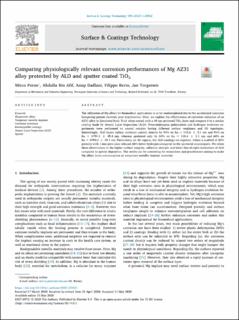| dc.contributor.author | Peron, Mirco | |
| dc.contributor.author | Bin Afif, Abdulla Shaikh Abdul Qader | |
| dc.contributor.author | Dadlani, Anup | |
| dc.contributor.author | Berto, Filippo | |
| dc.contributor.author | Torgersen, Jan | |
| dc.date.accessioned | 2021-04-22T11:08:18Z | |
| dc.date.available | 2021-04-22T11:08:18Z | |
| dc.date.created | 2020-05-20T11:46:06Z | |
| dc.date.issued | 2020 | |
| dc.identifier.citation | Surface & Coatings Technology. 2020, 395, . | en_US |
| dc.identifier.issn | 0257-8972 | |
| dc.identifier.uri | https://hdl.handle.net/11250/2739110 | |
| dc.description.abstract | The utilization of Mg alloys for biomedical applications is so far underexplored due to the accelerated corrosion hampering patient recovery post implantation. Here, we explore the effectiveness of corrosion reduction of an AZ31 alloy in Simulated Body Fluid when coated with a 40 nm sputtered TiO2 layer and compare it to a similar coating made by Atomic Layer Deposition (ALD). Potentiodynamic polarization and hydrogen evolution experiments were performed on coated samples having different surface roughness and 3D topologies. Interestingly, ALD layers reduce corrosion current density by 94% on Ra = 118.6 ± 5.1 nm and 93% on Ra = 4794.3 ± 49.4 nm, whereas sputtered only by 84% on Ra = 118.6 ± 5.1 nm and 60% on Ra = 4794.3 ± 49.4 nm. Particularly on 3D aspects, the ALD coatings are superior, where a scaffold of 85% porosity with 1 mm pore sizes released 68% lower hydrogen compared to the sputtered counterparts. We relate these observations to the higher surface integrity, adhesion strength and lower line-of-sight restrictions of ALD compared to sputter deposition. The results can be interesting for researchers and practitioners aiming to make Mg alloys more commonplace as temporary metallic implant materials. | en_US |
| dc.language.iso | eng | en_US |
| dc.publisher | Elsevier Science | en_US |
| dc.rights | Navngivelse 4.0 Internasjonal | * |
| dc.rights.uri | http://creativecommons.org/licenses/by/4.0/deed.no | * |
| dc.title | Comparing physiologically relevant corrosion performances of Mg AZ31 alloy protected by ALD and sputter coated TiO2 | en_US |
| dc.type | Peer reviewed | en_US |
| dc.type | Journal article | en_US |
| dc.description.version | publishedVersion | en_US |
| dc.source.pagenumber | 14 | en_US |
| dc.source.volume | 395 | en_US |
| dc.source.journal | Surface & Coatings Technology | en_US |
| dc.identifier.doi | 10.1016/j.surfcoat.2020.125922 | |
| dc.identifier.cristin | 1811888 | |
| dc.relation.project | Norges forskningsråd: 295864 | en_US |
| dc.description.localcode | This is an open access article distributed under the terms of the Creative Commons CC-BY license, which permits unrestricted use, distribution, and reproduction in any medium, provided the original work is properly cited. | en_US |
| dc.source.articlenumber | 125922 | en_US |
| cristin.ispublished | true | |
| cristin.fulltext | original | |
| cristin.qualitycode | 1 | |

